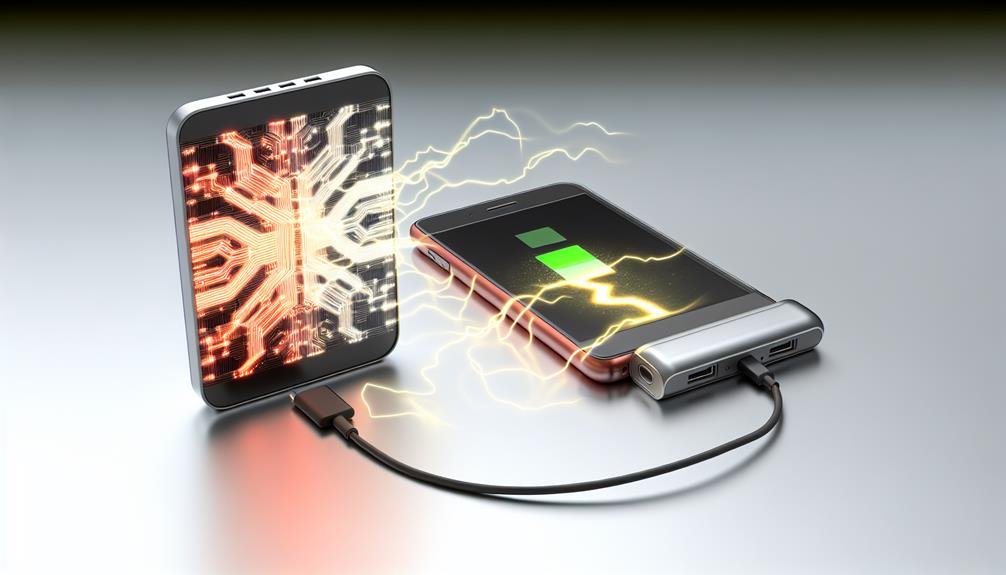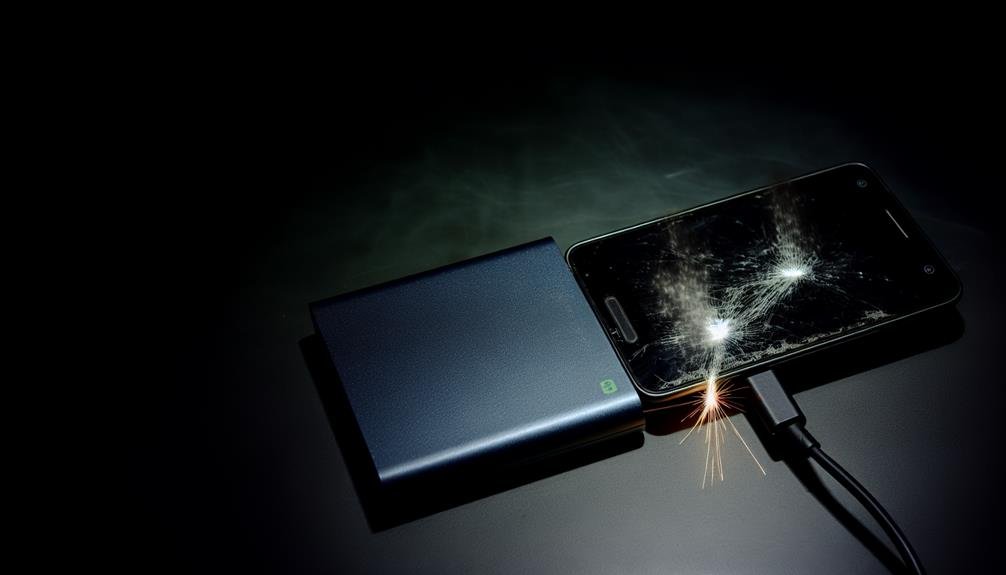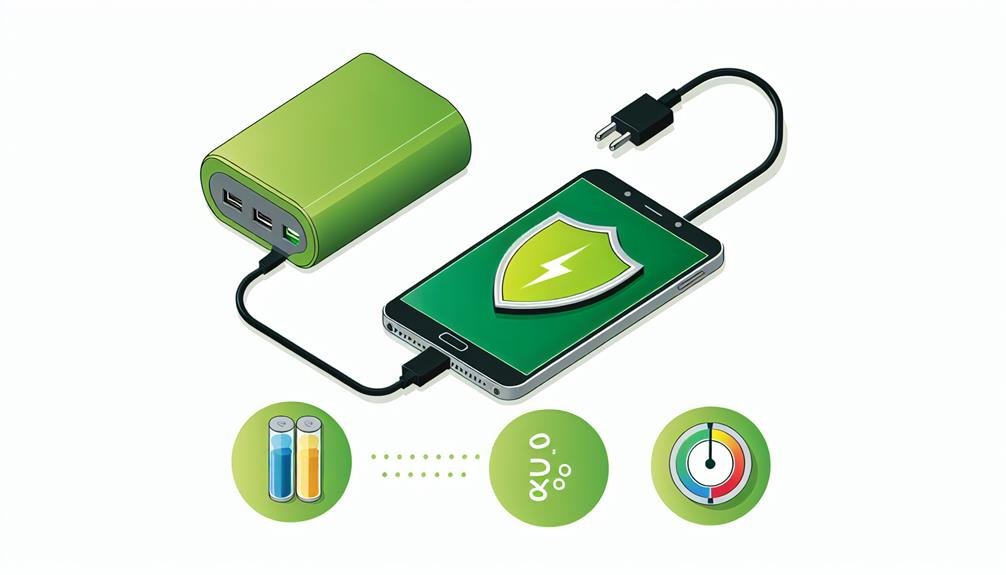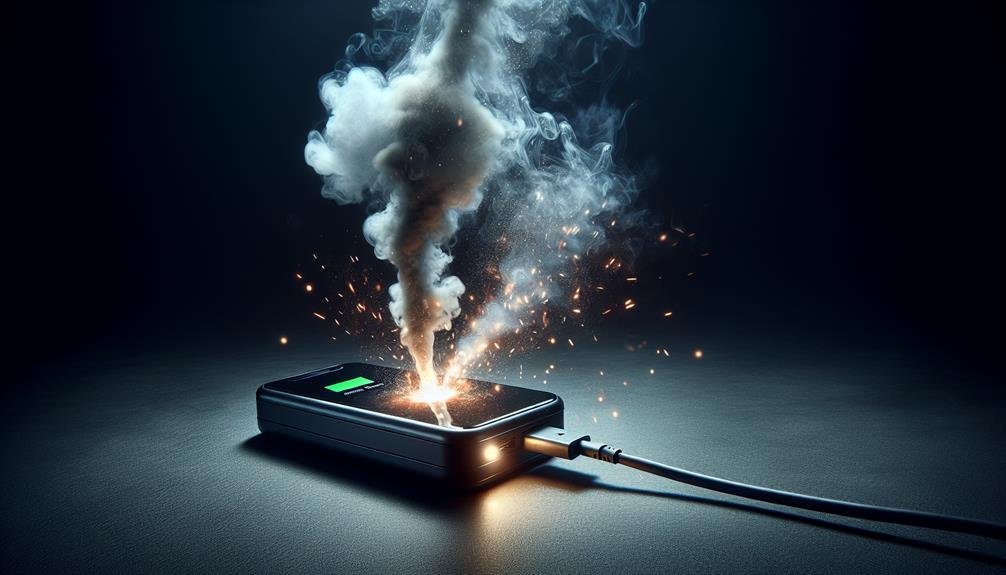Using a power bank can damage your phone if it's of poor quality or lacks proper safety features. Overcharging, voltage irregularities, and short circuits are the primary risks. Power banks should have intelligent circuits to prevent overcharging and match your phone's voltage and current requirements. Avoid substandard power banks; they can overheat and harm your phone. Always use certified cables and adapters, and keep an eye on charging cycles to maintain battery health. If you're keen on protecting your device, you'll want to understand the right way to choose and use power banks effectively.
Understanding Power Bank Technology

A power bank's core technology involves lithium-ion or lithium-polymer batteries, which store and deliver electrical energy to your phone. These batteries are designed to handle high energy densities, making them efficient for portable charging. When examining power banks, focus on two vital factors: battery capacity and charging speed.
Battery capacity, measured in milliampere-hours (mAh), tells you how much charge the power bank can hold. A higher capacity means more energy storage, allowing more charging cycles for your phone. However, larger capacity often requires more time to recharge the power bank itself, so balance is key.
Charging speed is another important aspect. It's typically indicated by the output current, measured in amperes (A). Standard ports usually offer 1A, while faster-charging models provide 2A or higher. Fast charging can be beneficial, but it's essential to verify that your phone supports it to avoid potential damage. Overloading your device with excessive current can lead to overheating, affecting both battery life and safety.
Common Power Bank Myths
Despite understanding the core technology and specifications of power banks, misconceptions around their use and effects persist widely. Many believe power banks can cause significant harm to phones, but these myths often lack factual basis. Let's debunk some common power bank misconceptions to guarantee your phone charging safety.
One prevalent myth is that using a power bank that isn't the phone's original charger will damage the battery. In reality, as long as the power bank delivers the correct voltage and current, there's no risk of damage. Another misconception is that power banks overcharge phones. Modern phones and power banks are equipped with intelligent circuits that prevent overcharging. Lastly, some think power banks degrade phone batteries faster. However, the rate of degradation is more influenced by how often you charge, rather than what you use to charge.
Here's a detailed look at these myths:
| Myth | Reality | Impact on Safety |
|---|---|---|
| Non-original chargers cause harm | Correct specs mean no damage | Ensures compatibility |
| Power banks overcharge phones | Intelligent circuits prevent overcharging | Protects battery health |
| Faster battery degradation | Charge frequency, not the power bank, affects degradation | Encourages proper charging habits |
Understanding these facts can help you use power banks safely and effectively.
Potential Risks to Phones

When evaluating potential risks to phones from power banks, it's important to take into account factors like voltage irregularities and substandard build quality. Power banks that don't meet safety standards can indeed pose several risks to your phone. Here's a breakdown of potential hazards:
- Overcharging Risks: Some power banks lack proper overcharge protection. This can lead to your phone's battery being charged beyond its best capacity, causing long-term damage and reducing battery life.
- Voltage Irregularities: If a power bank delivers inconsistent voltage, it can harm your phone's internal components. Voltage spikes or drops can lead to performance issues or even permanent damage.
- Short Circuit Dangers: Poorly designed power banks may lack short circuit protection. This can result in electrical shorts, which not only damage your phone but also pose a fire hazard.
- Substandard Build Quality: Inferior materials and construction can lead to overheating or physical damage. A power bank that overheats can adversely affect your phone, leading to potential safety concerns.
Choosing the Right Power Bank
Selecting the appropriate power bank involves analyzing key specifications like capacity, output voltage, and safety features to guarantee compatibility and reliability for your phone. Start by considering the capacity, measured in milliampere-hours (mAh). It should be adequate to charge your phone at least once or twice without overextending the power bank, which can impact its battery lifespan. For instance, a 10,000 mAh power bank can typically charge a 2,500 mAh phone battery about four times.
Next, examine the output voltage and current. Most smartphones require a 5V output, but newer models may support fast charging protocols that require higher voltages like 9V or 12V. Confirm the power bank matches or exceeds your phone's charging compatibility to avoid potential damage.
Safety features are essential. Look for power banks with overcharge protection, short circuit protection, and temperature control. These features prevent overheating and overloading, which could jeopardize both your phone and the power bank's battery lifespan.
Best Practices for Safe Charging

Consistently following best practices for safe charging can decrease the risk of damaging both your phone and power bank. Adhering to precise charging etiquette and focusing on battery care guarantees longevity and safety for your devices. Here are some key practices:
- Use Certified Cables and Adapters: Always employ manufacturer-approved or certified third-party cables and adapters. Uncertified accessories may not meet safety standards, heightening the risk of overheating or short circuits.
- Avoid Overcharging: Modern phones and power banks are designed to halt charging once they reach 100%, but it's still good practice to unplug them promptly. Prolonged charging can produce excess heat, potentially damaging the battery over time.
- Keep Devices Cool: Heat is a significant foe of battery health. Ensure your phone and power bank are kept in a cool environment while charging. Avoid covering them with blankets or placing them in direct sunlight.
- Monitor Charging Cycles: Pay attention to the charging cycles of both your phone and power bank. Lithium-ion batteries, commonly used in these devices, have a limited number of charge cycles. Regularly depleting the battery to 0% and then fully charging it can degrade battery life faster.
Frequently Asked Questions
Can Using a Power Bank Void My Phone's Warranty?
Using a power bank won't void your phone's warranty if the power bank compatibility is guaranteed. However, using incompatible models can raise safety concerns, potentially leading to damage and voiding your warranty. Always prioritize safety.
How Long Does a Power Bank Usually Last?
A power bank's lifespan can last an eternity—well, almost! Typically, it lasts 2-3 years, depending on usage and brand. Proper use minimizes the impact on battery health, ensuring your devices remain safe and efficient.
Are There Eco-Friendly Power Banks Available?
Yes, there are eco-friendly power banks available. They use sustainable materials and biodegradable options. Many incorporate renewable energy, like solar power integration, ensuring you can charge devices efficiently while minimizing environmental impact and maximizing safety.
Can Power Banks Charge Other Devices Besides Phones?
You wouldn't believe it, but power banks can charge everything from tablets to smartwatches! Their capabilities extend to laptop power and camera functionality. Always verify compatibility and safety features to avoid any potential issues.
What Should I Do if My Power Bank Gets Wet?
If your power bank gets wet, immediately disconnect it from any devices. Use drying methods like silica gel or rice. Follow troubleshooting steps to inspect for damage. Consider using alternative power sources until it's completely dry.



